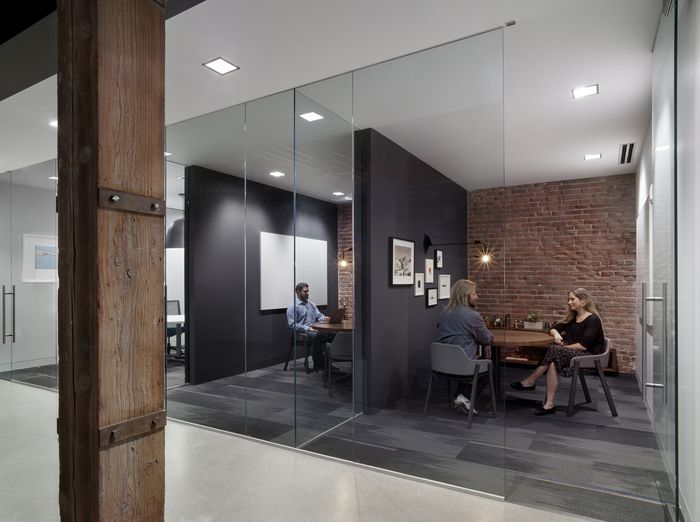A commercial lease’s Tenant Improvement Work Letter outlines any renovations needed to customize the space for the tenant’s use. This work letter can be structured many different ways. However, it’s ultimately the tenant’s responsibility to decide whether they or the landlord will manage the design and construction process. There’s no right or wrong choice. There are many variables at play. Determining factors can include anything from the buildout’s overall cost to the amount of the landlord’s TI allowance to how much project control the tenant wants. In this post, we’ll do our best to summarize the pros and cons of each option.
What is the Landlord Build-Out Option?
Many times, a landlord will offer a tenant build-out construction services as part of their TI allowance and package.
This option is popular with tenants since it provides them with a turn-key process. In fact, it’s commonly referred to as turnkey tenant improvements. It’s the landlord working directly with architects, designers, and general contractors to ready the space for tenant-use. All the tenant has to do is turn the key on move-in day.
It also looks like a win for the tenant since the landlord is assuming any risk of project overrun charges.
But not so fast. If you choose this option, you need to understand that you’re basically ordering from a menu. It’s similar to sitting down for a buffet-style meal. You’re paying a fixed price for whatever is included in the buffet – if you want something not included in the buffet, you pay more. In this case, the landlord is typically offering you “Building Standard” upgrades. These may include, but aren’t limited to:
- The Number of/Specific Types of Lighting Fixtures
- The Number of/Specific Types of Window Treatments
- The Number of Electrical Outlets Per Square Foot
- Standard Carpeting Grades/Colors
- Specific Door Styles
- Specific Ceiling Styles
- Specific Paint Grades or Colors
- Amount of Drywall
If you want anything outside of the defined “Building Standard” upgrades, you’re responsible for paying for it. As far as the landlord covering any project overrun costs, that doesn’t apply to any change requested by the tenant. And this may get tricky. Something as simple as requesting an additional electrical outlet or a specific lighting fixture can be viewed as a “Change Order” you’re responsible for.
While there are undoubtedly benefits to choosing a landlord or turnkey build-out, there are also a few things tenants need to be wary of.
First, there’s no way of knowing if the landlord and their chosen contractor are working with your best interests in mind. In most cases, they are. But, you must remember that a contractor’s allegiance and working arrangement is with the landlord, not you. That’s who they answer to. Especially if you completely remove yourself from the construction process.
You also need to trust the landlord or property management company you’re working with. They could be paying their contractor less for outlined work than they’re suggesting. If that’s the case, they’re likely pocketing money you could be using to cover other improvements. In some cases, they might also be cutting corners to stay under budget.
One potential workaround is for the tenant to arrange for their own contractor to come in. If that’s not an option, the tenant must become fully versed in all aspects of TI work. They must familiarize themselves with every Construction Drawing (CD) page to ensure nothing important is missed, forgotten, or overlooked going into construction.
Otherwise, the tenant runs the risk of accruing expensive Change Order requests once construction is underway.
You can’t rely on the landlord to manage the project from design through completion. They lack both the expertise and time. Only you can protect your best interests by staying on top of everything. As the tenant, you must do whatever you can to ensure you’re getting the most work you can from the landlord and their TI allowance. You also need to make sure all warranties are in place to ensure any involved party stands by their work. Additionally, you need to regularly check in with updates to make sure construction is on schedule for your target opening or move-in date.
What Is the Tenant Build-Out Option?
This is when complete control of the tenant build-out is given to the tenant. This is good whenever a tenant needs a higher level of involvement to ensure a given space is built exactly per their needs.
The tenant has complete direct control through every step of the process. From collaborating with architects, engineers, and designers to hiring and overseeing general contractors and tradesman like electricians or plumbers.
The landlord can review plans and offer additional insight, comments, or recommendations. From there, a construction schedule outlinling each phase or construction is created for effective planning and coordination.
In both tenant build-outs and landlord or turnkey build-outs, time must be allotted to secure proper permits and conduct field inspections to make sure no work in progress deviates from approved plans. After the build-out is completed, an additional walk through is necessary where a punchlist is marked off prior to project-close out.

